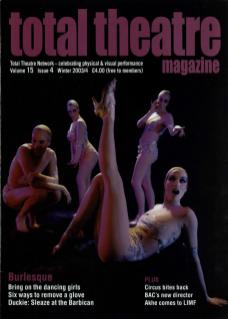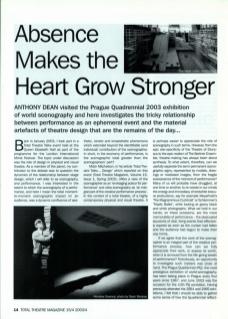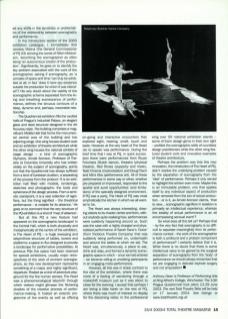Back in January 2003, I took part in a Total Theatre Talks event held at the Queen Elizabeth Hall as part of the programme for the London International Mime Festival. The topic under discussion was the role of design in physical and visual theatre. As a member of the panel, my contribution to the debate was to question the dynamics of the relationship between stage design, which I will refer to as scenography, and performance. I was interested in the extent to which the scenography of a performance, and here I mean the total moment-to-moment scenographic impact on an audience, was a dynamic confluence of aesthetic, kinetic and kinaesthetic phenomena which extended beyond the identifiable (and individual) contribution of the scenographer. In short, in the economy of performance, is the scenographic total greater than the scenographer’s part?
Mitch Mitchelson, in his article ‘Total Theatre Talks... Design' which reported on this event (Total Theatre Magazine, Volume 15, Issue 1, Spring 2003), offers a view of the scenographer as an 'envisaging auteur for performance’ and cites scenography as 'an integral part of the creative performance process'. In the context of a total theatre, of a highly contemporary physical and visual theatre, it is perhaps easier to appreciate the role of scenography in such terms. However, from the epic site-specificity of the Theatre of Dionysus to the epic-realism of The Berliner Ensemble, theatre-making has always been about synthesis. To what extent, therefore, can we usefully separate the semi-permanent scenographic signs, represented by models, drawings or mediated images, from the fragile evanescence of the moment of performance? Many of us will probably have struggled, at one time or another, to recreate in our minds the energy and immediacy of erstwhile bravura productions, say for example Meyerhold's The Magnanimous Cuckhold or Schlemmer's Triadic Ballet, while looking at grainy black and white photographs. What we hold in our hands, on these occasions, are the mere memorabilia of performance – the desiccated souvenirs of vital, living events that effectively expired as soon as the curtain had fallen and the audience had begun to make their way home.
If we agree that the work of the scenographer is an integral part of the creative performance process, how can we fully appreciate their work, or assess its worth, when it is removed from the life-giving breath of performance? Fortuitously, an opportunity to investigate such matters was close at hand. The Prague Quadrennial (PQ), the most prestigious exhibition of world-scenography, has been taking place in Prague every four years since 1967, and June 2003 was the occasion for the 10th PQ exhibition. Having previously attended the 1991 and 1995 exhibitions, I felt that I should be able to gather some sense of how the Quadrennial reflected any shifts in the dynamics or problematics of the relationship between scenography and performance.
In the introductory section of the 2003 exhibition catalogue, I immediately find Jaroslav Malina (the General Commissioner of PQ 03) echoing the words of Mitch Mitchelson, describing the scenographer as often being an autonomous creator of the ‘production'. Significantly, he goes on to identify the key problem associated with the work of the scenographer, asking if scenography, as 'a complex of space and time' can truly be exhibited at all; in fact 'does it have any existence outside the production for which it was intended'? His very doubt about the validity of the scenographic schema separated from the living and breathing evanescence of performance, defines the sinuous contours of a deep, dynamic and, perhaps, inexorable relationship.
The Quadrennial exhibition fills the vaulted halls of Prague's Industrial Palace, an elegant glass and steel structure designed in the Art Nouveau style. The building comprises a magnificent Middle Hall that forms the monumental central core of the building and two adjoining wings. One wing houses student work and an exhibition of theatre architecture while the other wing houses the national exhibits of stage design – a kind of scenographic Olympics. Arnold Aronson, Professor of Theatre at Columbia University who has written widely on the subject of scenography, points out that the Quadrennial has always suffered from a kind of Cartesian dualism, a separating of the process from the product: 'It is an exhibition hall filled with models, renderings, sketches and photographs: the tools and ephemera of the design process. From a semiotic standpoint, it is a vast collection of signifiers, but the thing signified – the theatrical performance – is notable for its absence. He goes on to comment that the very structure of the PQ exhibition is a kind of ‘map of absence'.
But at this PQ a new feature had appeared on the scenographic landscape! In the Central Hall, which is both physically and metaphorically at the centre of the exhibition, is The Heart of PQ – a huge sweeping and labyrinthine structure of tables, towers and platforms: a space-in-flux designed to provide a landscape for performative possibilities. At previous PQs this space had been reserved for special exhibitions, usually major retrospectives of the work of eminent scenographers, so this new development represents something of a major, and highly significant, departure. Posited as a kind of adventure playground for the five human senses, The Heart was a phenomenological labyrinth through which visitors might glimpse the flickering shadow of the creative process of performance-making. It hosted an eclectic programme of live events as well as offering ongoing and interactive encounters that explored sight, hearing, smell, touch and taste. However, at the very heart of The Heart (so to speak) was performance. During the brief time that I was at PQ, in quick succession there were performances from Ryuzo Fukuhara (Butoh dance), Krepsko (physical theatre), Red Shoes (puppetry and mask), Teatr Cinema (improvisation) and Doug Fitsch and Mimi Oka (performance art). All of these performances in some way or other, whether pre-prepared or improvised, responded to the spatial and aural opportunities (and limitations) of the specially designed environment. If PQ was a party, The Heart of PQ was most emphatically the kitchen in which we all wanted to be.
The Heart was always interesting, drawing visitors to its chaotic centre and then, without anybody quite realising how, performances were suddenly happening around us. Such was the case with a highly charged and physicalised performance of Sarah Kane's Crave (from Tricklock Theatre Company) that was suddenly being performed on, underneath and around the tables at which we sat. The Heart was, simultaneously, a place to eat, drink and relax, and formed a dynamic scenographic space in which – once we had entered – we became willing or unwitting participants in an engaging meta-performance.
However, all this was in sharp contrast to the rest of the exhibition, where there was more of a feeling of wandering through a makeshift museum just as it was about to close for the evening. I accept that perhaps I am being a little harsh on the rest of PQ, where there was much of interest on display for the discerning visitor. In the professional wing over 50 national exhibition stands – some of them design gems in their own right – profiled the scenographic skills of countless design practitioners while the other wing featured student work and innovative examples of theatre architecture.
Perhaps the problem was that this new innovation, the introduction of The Heart of PQ, didn't resolve the underlying problem caused by the separation of scenography from the 'elixir' of performance. Perhaps it only served to highlight this schism even more. Maybe this is an immutable problem, one that applies itself to any individual aspect of production when removed from the loci of actual production – or is it, as Arnold Aronson claims, ‘that to view... scenographic signifiers in isolation is primarily an intellectual experience, whereas the totality of actual performance is an all encompassing sensual event’?
So what does all this tell us? Perhaps that – by the very fact that scenography is so difficult to separate meaningfully from its performance context – the work of the scenographer is both a profound and a protean component of performance? I certainly believe that it is. While there is no doubt that there is some intellectual value to be gained by the surgical separation of scenography from the body of performance we should always remember that we are engaging in delicate keyhole surgery and not amputation!
Anthony Dean is Professor of Performing Arts at King Alfred's College, Winchester. The 10th Prague Quadrennial took place 13-29 June 2003. The next Total Theatre Talks will be held on 17 January 2004. See listings or www.totaltheatre.org.uk


